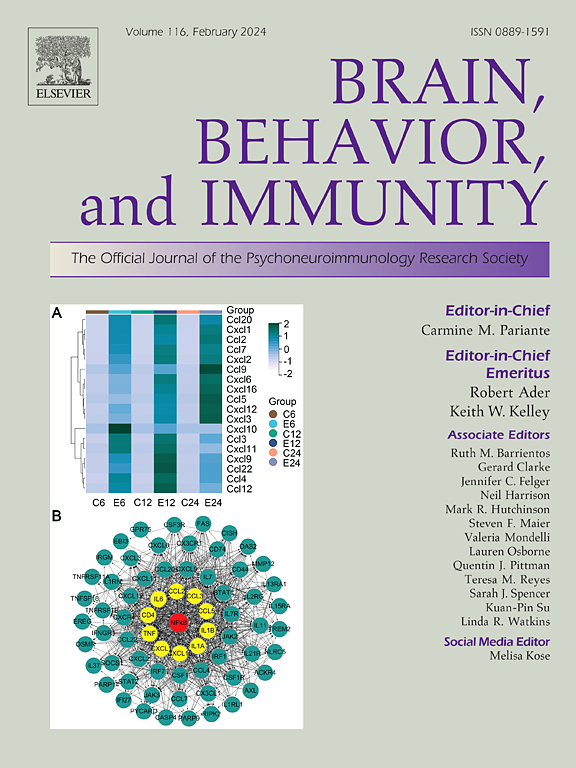Microglial SIRT2 deficiency aggravates cognitive decline and amyloid pathology in Alzheimer’s disease
IF 8.8
2区 医学
Q1 IMMUNOLOGY
引用次数: 0
Abstract
Sirtuin 2 (SIRT2), a NAD+-dependent deacetylase, has been implicated in aging and neurodegenerative diseases such as Alzheimer’s disease (AD). While global SIRT2 inhibition has shown promise in reducing amyloid-beta pathology and cognitive deficits in different mouse models of AD, peripheral SIRT2 inhibition has been associated with adverse effects, such as increased inflammation. This suggests that targeted inhibition of specific cellular populations within the brain may represent a more precise and effective approach for the treatment of AD. To explore this hypothesis, we generated a conditional microglial SIRT2 knockout mouse model in the context of AD. Our results reveal that microglial SIRT2 reduction does not confer protective effects in the APP/PS1 model; rather, it aggravates cognitive decline, accelerates amyloid plaque deposition, and increases levels of pro-inflammatory cytokines at early stages of AD pathology. Transcriptomic analysis further indicates that SIRT2-deficient microglia exhibit altered expression of genes associated with aging and synaptic dysfunction. This phenotype was accompanied by increased phagocytosis of PSD95 and impaired long-term potentiation. These findings suggest that while SIRT2 inhibition in some contexts may be beneficial, targeted inhibition within microglia could accelerate AD progression, underscoring the need for cell-specific approaches when considering SIRT2 as a therapeutic target.
小胶质细胞SIRT2缺陷加重阿尔茨海默病的认知能力下降和淀粉样蛋白病理
Sirtuin 2 (SIRT2)是一种NAD+依赖的去乙酰化酶,与衰老和神经退行性疾病如阿尔茨海默病(AD)有关。虽然在不同的AD小鼠模型中,全局SIRT2抑制已显示出减少淀粉样蛋白病理和认知缺陷的希望,但外周SIRT2抑制已与不良反应相关,如炎症增加。这表明,对大脑内特定细胞群的靶向抑制可能是一种更精确和有效的治疗阿尔茨海默病的方法。为了探索这一假设,我们在AD背景下建立了一个条件小胶质SIRT2敲除小鼠模型。我们的研究结果表明,在APP/PS1模型中,小胶质细胞SIRT2减少不具有保护作用;相反,它会加重认知能力下降,加速淀粉样斑块沉积,并在阿尔茨海默病的早期病理阶段增加促炎细胞因子的水平。转录组学分析进一步表明sirt2缺陷小胶质细胞表现出与衰老和突触功能障碍相关的基因表达改变。这种表型伴随着PSD95的吞噬增加和长期增强功能受损。这些发现表明,虽然SIRT2抑制在某些情况下可能是有益的,但小胶质细胞内的靶向抑制可能会加速AD的进展,强调在考虑将SIRT2作为治疗靶点时需要细胞特异性方法。
本文章由计算机程序翻译,如有差异,请以英文原文为准。
求助全文
约1分钟内获得全文
求助全文
来源期刊
CiteScore
29.60
自引率
2.00%
发文量
290
审稿时长
28 days
期刊介绍:
Established in 1987, Brain, Behavior, and Immunity proudly serves as the official journal of the Psychoneuroimmunology Research Society (PNIRS). This pioneering journal is dedicated to publishing peer-reviewed basic, experimental, and clinical studies that explore the intricate interactions among behavioral, neural, endocrine, and immune systems in both humans and animals.
As an international and interdisciplinary platform, Brain, Behavior, and Immunity focuses on original research spanning neuroscience, immunology, integrative physiology, behavioral biology, psychiatry, psychology, and clinical medicine. The journal is inclusive of research conducted at various levels, including molecular, cellular, social, and whole organism perspectives. With a commitment to efficiency, the journal facilitates online submission and review, ensuring timely publication of experimental results. Manuscripts typically undergo peer review and are returned to authors within 30 days of submission. It's worth noting that Brain, Behavior, and Immunity, published eight times a year, does not impose submission fees or page charges, fostering an open and accessible platform for scientific discourse.

 求助内容:
求助内容: 应助结果提醒方式:
应助结果提醒方式:


